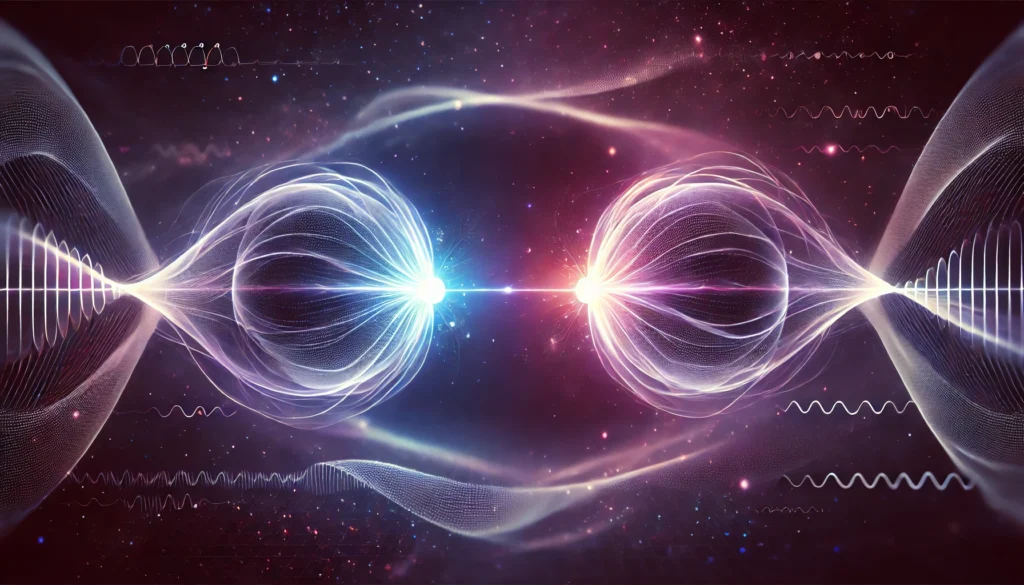Imagine flipping two coins, and no matter how far apart they are, they always land on opposite sides. Sounds impossible, right? In the bizarre world of quantum physics, this is exactly what happens with quantum entanglement. It’s a phenomenon that Einstein famously called “spooky action at a distance,” and it continues to baffle and intrigue scientists today.
What is Quantum Entanglement?
Quantum entanglement occurs when two or more particles become linked, or “entangled,” in such a way that their fates are intertwined. Even when separated by vast distances, measuring the properties of one particle instantaneously affects the properties of the other.
Here’s a simplified explanation:
- Entangled Pairs: Particles can become entangled through interactions, such as during certain particle decays or when photons are emitted from a common source.
- Shared State: These entangled particles share a single quantum state, meaning their properties are correlated.
- Instantaneous Correlation: If you measure a property of one entangled particle (like its spin), you instantly know the corresponding property of the other particle, regardless of the distance between them.
The “Spooky” Aspect:
The “spooky” part is that this correlation appears to happen instantaneously, faster than the speed of light. This challenged Einstein’s theory of relativity, which states that nothing can travel faster than light. However, experiments have consistently confirmed the existence of entanglement.
How Does It Work? (Sort Of…)
It’s important to understand that entanglement doesn’t involve sending information faster than light. Instead, it’s about the inherent interconnectedness of the particles’ quantum states.
Think of it this way:
- Before measurement, the properties of the entangled particles are undefined, existing in a superposition of possible states.
- The act of measurement forces one particle to “choose” a specific state.
- Because the particles are entangled, the other particle instantly “chooses” the corresponding state.
Why is Entanglement Important?
Quantum entanglement has profound implications for various fields:
- Quantum Computing: Entangled particles are essential for building powerful quantum computers that can perform calculations far beyond the capabilities of classical computers.
- Quantum Communication: Entanglement can be used to create secure communication channels that are theoretically unbreakable.
- Quantum Cryptography: Entanglement allows for the secure distribution of cryptographic keys.
- Quantum Teleportation: While not teleporting matter in the science fiction sense, quantum teleportation involves transferring the quantum state of one particle to another.
- Fundamental Physics: Studying entanglement helps us understand the fundamental nature of reality and the laws of quantum mechanics.
The Ongoing Mystery:
Despite its practical applications, quantum entanglement remains a deep mystery. Scientists are still exploring:
- The precise mechanisms behind entanglement.
- The relationship between entanglement and spacetime.
- The implications of entanglement for our understanding of reality.
See also Unlocking the Secrets of Photosynthesis: How Plants Power the World
Conclusion:
Quantum entanglement is a mind-bending phenomenon that challenges our classical understanding of the universe. While it may seem like science fiction, it’s a real and measurable effect with the potential to revolutionize technology and our understanding of the cosmos. As we delve deeper into the quantum realm, we’re sure to uncover even more of its secrets.
Reference Links:
- Caltech: Quantum Entanglement – https://www.caltech.edu/about/news/quantum-entanglement-what-is-it
- ScienceDaily: Quantum Entanglement – https://www.sciencedaily.com/terms/quantum_entanglement.htm
- PBS NOVA: What is Quantum Entanglement? – https://www.pbs.org/wgbh/nova/article/quantum-entanglement/
- Wikipedia: Quantum Entanglement – https://en.wikipedia.org/wiki/Quantum_entanglement



